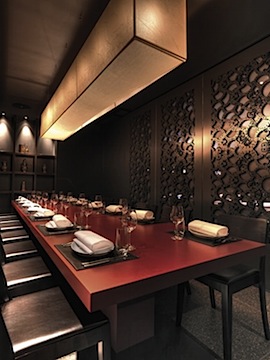The food was exceptional but what I came away from the meal with was well it was an ‘experience’ and not just a ‘meal’. A number of things went into the 3 hours that we dined at Maha that stood out and left me pondering what I could learn from the success of this restaurant and apply to my own business.


Throughout the meal it was not just our taste buds that were stimulated. In the corner a three piece band played middle eastern music, outside was a court yard where people smoked shi sha pipes (creating sweet smell that drifted into the room) and at the end of the meal we were offered to have our hands rinsed in a little lemon cologne which engaged both our senses of smell but also touch.

Lesson #1: First Impressions and the Power of Contrast
Walking into Maha there was an immediate transformation that occurred that drew us into the experience.
Situated on a small and fairly interesting street filled with the back ends of buildings and car parks (I have to say I wasn’t expecting much of a place in this part of the city) – Maha’s fit out immediately created an impression that lasted for the rest of the afternoon (and beyond).
It was anything but like the street outside and was a luxurious yet tasteful version of a middle eastern dining room. Dark, cosy and inviting – in stark contrast to the bright, stark, surrounds of concrete outside.
Lessons: first impressions matter and creates a lasting impression that sets up the experience.
Lesson #2: Simplified Dining
Sometimes dining in places like Maha can be an overwhelming experience, being confronted with a menu filled with dishes that need translation, and feeling overwhelmed with a wine list, with so many options, no idea where to start isn’t anyones idea of a great way to start a meal.
Instead at Maha we were warmly greeted, seated and giving a very simple drinks menu (with an invitation for a more extensive one if we required it). The menu for the day was a banquet (chefs choice – although we could have some input if we had special needs) which I also appreciated. Conversation was not interrupted with choices of food and drinks and the overwhelming nature of those menus and wine lists were eliminated.
Lessons: choice is great but sometimes it can be overwhelming and simplicity can be appreciated.
Lesson #3: Engaging the Senses

Throughout the meal it was not just our taste buds that were stimulated. In the corner a three piece band played middle eastern music, outside was a court yard where people smoked shi sha pipes (creating sweet smell that drifted into the room) and at the end of the meal we were offered to have our hands rinsed in a little lemon cologne which engaged both our senses of smell but also touch.
The cologne also made a lasting impression – as I fell asleep the fragrance lingered on, and I was once again reminded of the experience of Maha.
Lesson: engage the senses and you transform something that can be quite one dimensional into something experiential.
Lesson #4: Unexpected Gifts
When it came time for the bill to be brought to the table the waitress also delivered three small white boxes (one for each couple) with some small pastries in them. They were a little take home gift to extend our visit.
These gifts served a several purposes including: something we didn’t ‘pay for’ – it is amazing what impression getting something for free makes (or course we DID pay for the gift as the pastries would not have cost much and our bill more than covered it). This perceived extra value and a gift will of course create a lasting impression, increase the chances of us returning and telling our friends about the experience.
- extending the experience – today as I ate a pastry (24 hours after dining at Maha) I’m still thinking about the meal.
Lesson: gifts (big and small) and extra value create an impression!
Lesson 5: Focus Upon the Positive
As we were about to leave our waitress stopped by the table. Instead of asking if everything was ok (often the way wait staff word this question) our waitress asked us what our favourite part of the meal was?
By asking what was the best part of the meal, shifted our minds away from parts we might not have enjoyed (not that there were any for me) and onto the best parts of the meal just as we were about to leave. We left pondering the good rather than what could have been better.
By asking what was the best part of the meal, shifted our minds away from parts we might not have enjoyed (not that there were any for me) and onto the best parts of the meal just as we were about to leave. We left pondering the good rather than what could have been better.
This also served as a great way for the staff to gather feedback on what was working – something that no doubt helps them to continue to improve what they do.
Lesson 6: Choreography/Process
Our experience didn’t just happen. Everything from the way in which we were greeted, through to the small touches like the lemon cologne and complimentary pastries were intentional and planned steps in a choreography of a typical visit to Maha.
I’m certain that the process evolved over time but the experience was not left to chance – there was a clearly thought through process in place which ensured the best chances of a great experience for diners and a profitable business.
Best of all, the ‘choreography’ wasn’t obvious or intrusive in any way, it just naturally unfolded.
Lesson: great experiences don’t always just happen. A little thought can go a long way to helping people move through an experience in a positive way.
Which of these principles could you take and apply in your blog or online business?








 partygirl@hotmail.com.... sound like a professional email address?
partygirl@hotmail.com.... sound like a professional email address?




